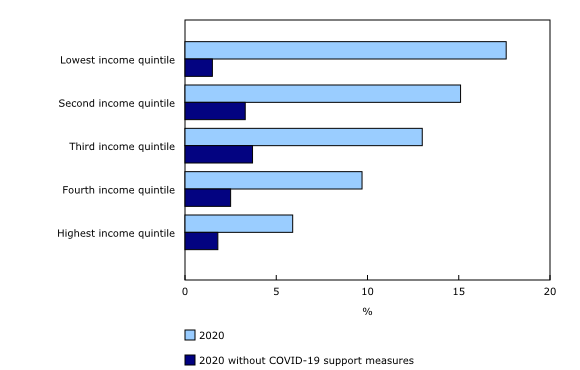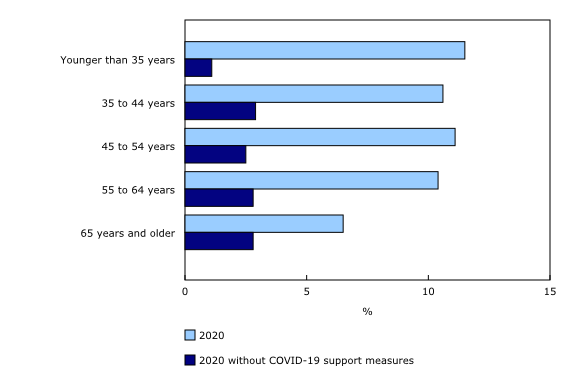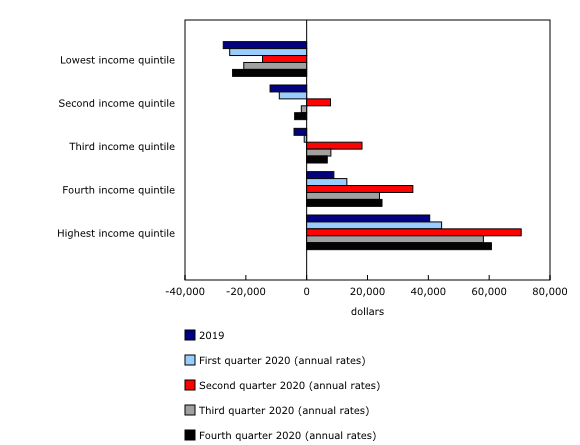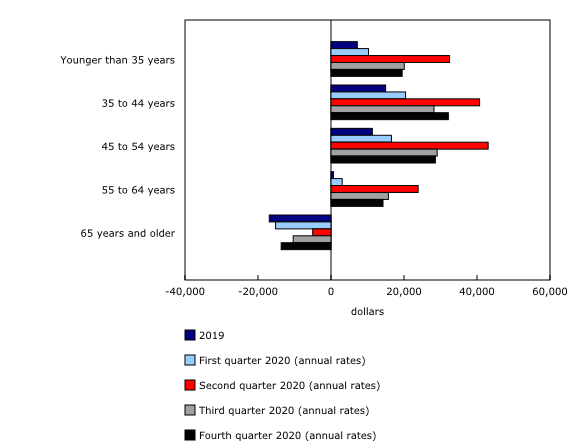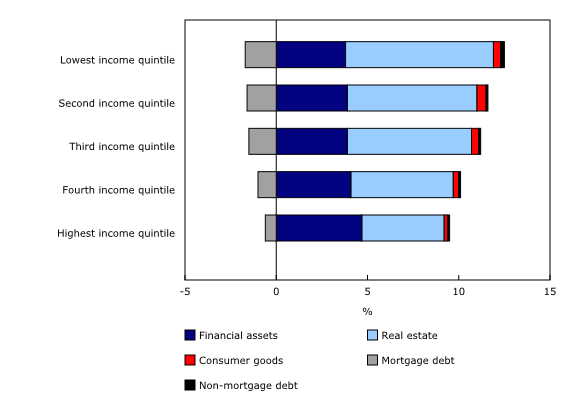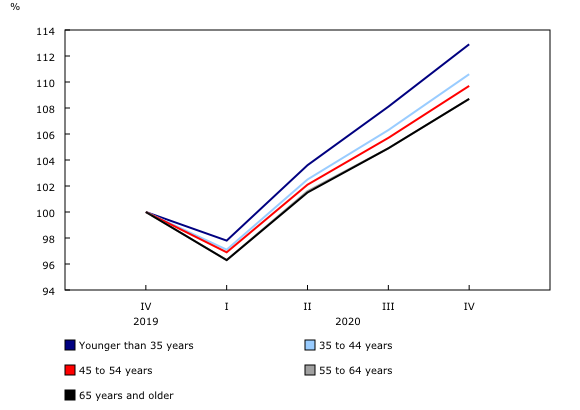Household economic well-being during the COVID-19 pandemic, experimental estimates, fourth quarter 2020
Archived Content
Information identified as archived is provided for reference, research or recordkeeping purposes. It is not subject to the Government of Canada Web Standards and has not been altered or updated since it was archived. Please "contact us" to request a format other than those available.
Released: 2021-05-28
Despite declines in disposable income in the fourth quarter, all households recorded higher income in 2020 compared with 2019. Lower- and middle-income earners recorded the largest annual increases in disposable income, as government COVID-19 support measures outpaced losses in compensation of employees and self-employment mixed income. As a result, the gap between the lowest- and highest-income households, calculated as the difference between their respective shares of total disposable income, shrank 1.9 percentage points in 2020 compared with 2019.
The economic well-being of the lowest-income earners increased more than that of any other households in 2020, with those in the lowest income quintile recording gains of 17.6% in disposable income and 10.7% in net worth relative to 2019. Gains in net worth for the lowest-income earners were driven by larger percentage increases in real estate assets that outpaced increases in mortgage debt. Households in the lowest income quintile reduced their non-mortgage debt by more than other households, also contributing to their larger percentage gain in net worth in 2020.
Despite fourth-quarter declines, household income up in 2020
Disposable income declined for most households in the fourth quarter of 2020, with the largest losses for the lowest-income earners (-10.2%). Despite declines at the end of the year, lower- and middle-income households recorded the largest increases in disposable income, rising by 13.0% to 17.6% in 2020 compared with 2019. The overall gains were led by unprecedented increases in current transfers in the second quarter, as governments' COVID-19 support measures were implemented to help mitigate negative impacts from the pandemic.
If the government had not provided financial support to households, their disposable income would still have increased in 2020, but to a much lesser extent. Excluding the COVID-19 support measures, the lowest-income and youngest households would have seen the smallest gain in disposable income. This is because the COVID-19 support measures had a larger overall impact on the disposable income of the lowest-income and youngest earners in Canada, representing 9% to 14% of their total income in 2020. It is important to note that this analysis only estimates the direct impact of government transfers on household disposable income. It does not take into consideration any indirect impacts that government support measures had on household economic or financial well-being. These include the potential effects of economic scarring in the absence of such measures, including an increased incidence of job loss or insolvencies.
Lowest-income and youngest households see largest wage losses in 2020
In contrast to disposable income, compensation of employees—of which wages and salaries make up the largest share—was up in the fourth quarter, with lower-income and older households (65 years and older) recording the biggest gains. Despite the uptick in the second half of the year, compensation of employees was lower in 2020 compared with 2019 for all households. The most pronounced wage losses were experienced by the lowest-income (-5.3%) and the youngest (-3.1%) households, as many people in these households work in industries or jobs hard hit by the pandemic.
Employment Insurance benefits rise in fourth quarter as COVID-19 support measures ease
In fall 2020, the federal government modified Employment Insurance (EI) eligibility and implemented three new COVID-19 support measures to provide financial assistance to households unable to qualify for EI. The result of these changes was a decline in COVID-19-specific support measures and a significant rise in EI benefits in the fourth quarter of 2020. While all households recorded notable increases in EI benefits in the fourth quarter, those younger than 45 had the largest uptick.
Despite rebound in the second half of the year, household spending down and net saving up in 2020
Household spending rose as pandemic restrictions continued to ease in the fourth quarter, with lower-income and older households (65 years and older) posting the largest increases. Despite the uptick in the second half of the year, overall consumption expenditure was down in 2020 compared with 2019. The youngest and highest-income earners recorded the biggest declines, reducing their consumption expenditure by 5.7% and 7.0%, respectively.
In the fourth quarter of 2020, net saving for many households declined as their disposable income decreased and consumption edged up. The only households to record gains in net saving in the fourth quarter were the highest-income earners and those with a major income earner aged 35 to 44 years.
Although net saving declined for many at the end of the year, all households recorded improved net saving in 2020 compared with 2019. Middle-income households experienced some of the biggest gains as they switched to a net saving position in 2020 from a net dissaving position in 2019.
Lowest-income earners see their wealth increase the most throughout the year, because of gains in real estate
Household wealth reached $12.8 trillion as of the fourth quarter of 2020, up $461 billion from the third quarter, with each disposable income quintile growing at roughly the same pace (about +4.0%) over that period. Throughout the year, wealth grew more for the lowest-income earners (+10.7%) compared with the highest-income earners (+9.0%), mainly because of consistently higher gains in real estate.
Lower-income households increase their mortgage debt the most throughout the year, while they rely less on non-mortgage debt to finance consumer goods purchases
While fourth-quarter growth in mortgage debt was similar for all households (roughly +2% relative to the third quarter of 2020), lower-income households increased their mortgage debt obligations the most throughout the year (by more than 7% relative to the fourth quarter of 2019), along with higher increases in the value of their real estate acquisitions.
After business shutdowns were eased in the latter half of the year, all households increased their acquisition of consumer goods, such as cars, electronics and appliances. While lower-income households increased their non-mortgage debt to purchase consumer goods in the fourth quarter, the highest-income earners avoided additional borrowing. Households in the three lowest income quintiles collectively accounted for 83.8% of the $1.6 billion increase in non-mortgage debt in the fourth quarter. However, for the entire year, all households decreased their non-mortgage debt obligations, especially the lowest-income earners (-1.6%).
Younger households increase their wealth by more than older households as gains in real estate and consumer goods purchases outpace increases in debt
Although households with a major income earner younger than 35 held the least wealth of any age group, they saw their average net worth increase by more than that of older households. Similar to trends earlier in the year, which were driven by gains in value in the acquisition of real estate that outpaced growth in mortgage debt obligations, the net worth of households with a major income earner younger than 35 rose 4.5% in the fourth quarter, while net worth for those with a major income earner aged 55 or older grew by 3.6%.
Along with continued low mortgage lending rates offered by financial institutions as a result of the pandemic, younger households increased their mortgage debt by more than older households in the fourth quarter. Average mortgage debt for households with a major income earner younger than 35 rose 3.5% in the fourth quarter, while all other age groups increased their mortgage debt by less than 2% relative to the previous quarter.
As well, households with a major income earner younger than 35 increased their holdings of consumer goods by 2.8% in the fourth quarter, more than double the rate of any other age group. However, most of these purchases were financed through savings or debt consolidation rather than through additional borrowing—the non-mortgage debt of households with a major income earner younger than 35 grew 1.3% in the same quarter.
Debt-to-income ratio grows most for lower-income earners and younger households, but remains below pre-pandemic levels
The debt-to-income ratio increased the most for households in the lowest income quintile, reaching 259.5% in the fourth quarter (up 30.3 percentage points from the third quarter), and for those younger than 35 years, reaching 199.9% (up 8.6 percentage points). While mortgage debt continued to grow in the fourth quarter, increases in employment earnings were offset by reductions in pandemic-related government benefits. Despite fourth-quarter increases, households' debt-to-income ratios remained below pre-pandemic levels.
As the effects of the pandemic continue to filter through the economy, upcoming quarterly releases on the distributions of household economic accounts will shed further light on the evolution of household economic well-being throughout the 2021 reference year and beyond.
Note to readers
Statistics Canada regularly publishes macroeconomic indicators on household disposable income, final consumption expenditure, net saving and wealth as part of the Canadian System of Macroeconomic Accounts (CSMA). These accounts are aligned with the most recent international standards and are compiled for all sectors of the economy, including households, non-profit institutions, governments and corporations, along with Canada's financial position vis-à-vis the rest of the world. While the CSMA provides high-quality information on the overall position of households relative to other economic sectors, the distributions of household economic accounts (DHEA) provide additional granularity to address questions such as vulnerabilities of specific groups and the resulting implications for economic well-being and financial stability. They are therefore an important complement to standard quarterly outputs related to the economy.
The quarterly DHEA estimates released today are experimental estimates of income, consumption, saving and wealth and their sub-components by various household distributions for 2020. Estimates for the first to the third quarters have been revised to include the latest CSMA benchmarks, as well as new microdata on household income, consumption and wealth.
As with all data, these experimental quarterly DHEA estimates are not without their limitations. For the most part, these experimental data rely on the same concepts and methods as the annual DHEA. However, to produce the DHEA on a quarterly basis, new data sources were used and assumptions were made. DHEA estimates for wages and salaries were derived using Statistics Canada's Social Policy Simulation Database and Model, which incorporate data from the Labour Force Survey for employment by industry and wage level. The distributions of the Canada Emergency Response Benefit were aligned with microdata from Employment and Social Development Canada. Aggregate data on DHEA liabilities were distributed to household groups using sub-aggregate data purchased from a consumer credit rating agency. Because of scarcity in available microdata sources, aggregate estimates of DHEA household final consumption expenditure and household assets were allocated according to the DHEA distributions for reference year 2019.
In an effort to estimate the impact of the COVID-19 pandemic on the economic well-being of households in Canada, these experimental DHEA estimates hold constant the demographic and socioeconomic characteristics of 2019 when estimating quarterly changes in income, consumption, saving and wealth throughout 2020. It is therefore assumed that all households remained in the same distributional category in which they were in the 2019 DHEA (e.g., age group, equivalized disposable income quintile, household composition). When the socioeconomic and demographic characteristics of 2019 are held constant, it is possible to estimate changes in various household economic indicators without intersecting with changes attributable to households moving across distributional groups. This approach allows for a clearer identification of the economic impacts of the COVID-19 pandemic on household distributions, as well as the associated impacts of economic restrictions and government support measures on household economic well-being.
The DHEA estimates released today are benchmarked to the quarterly income and expenditure accounts and the national balance sheet accounts published in March 2021. All values are expressed in quarterly nominal unadjusted rates, unless otherwise specified.
Products
The Economic accounts statistics portal, accessible from the Subjects module of our website, features an up-to-date portrait of national and provincial economies and their structure.
The Latest Developments in the Canadian Economic Accounts (13-605-X) is available.
The User Guide: Canadian System of Macroeconomic Accounts (13-606-G) is available.
The Methodological Guide: Canadian System of Macroeconomic Accounts (13-607-X) is available.
Contact information
For more information, or to enquire about the concepts, methods or data quality of this release, contact us (toll-free 1-800-263-1136; 514-283-8300; STATCAN.infostats-infostats.STATCAN@canada.ca) or Media Relations (613-951-4636; STATCAN.mediahotline-ligneinfomedias.STATCAN@canada.ca).
- Date modified:


